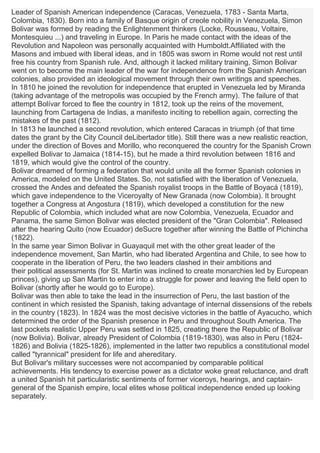
Tarea de ingles
- 1. Leader of Spanish American independence (Caracas, Venezuela, 1783 - Santa Marta, Colombia, 1830). Born into a family of Basque origin of creole nobility in Venezuela, Simon Bolivar was formed by reading the Enlightenment thinkers (Locke, Rousseau, Voltaire, Montesquieu ...) and traveling in Europe. In Paris he made contact with the ideas of the Revolution and Napoleon was personally acquainted with Humboldt.Affiliated with the Masons and imbued with liberal ideas, and in 1805 was sworn in Rome would not rest until free his country from Spanish rule. And, although it lacked military training, Simon Bolivar went on to become the main leader of the war for independence from the Spanish American colonies, also provided an ideological movement through their own writings and speeches. In 1810 he joined the revolution for independence that erupted in Venezuela led by Miranda (taking advantage of the metropolis was occupied by the French army). The failure of that attempt Bolívar forced to flee the country in 1812, took up the reins of the movement, launching from Cartagena de Indias, a manifesto inciting to rebellion again, correcting the mistakes of the past (1812). In 1813 he launched a second revolution, which entered Caracas in triumph (of that time dates the grant by the City Council deLibertador title). Still there was a new realistic reaction, under the direction of Boves and Morillo, who reconquered the country for the Spanish Crown expelled Bolivar to Jamaica (1814-15), but he made a third revolution between 1816 and 1819, which would give the control of the country. Bolivar dreamed of forming a federation that would unite all the former Spanish colonies in America, modeled on the United States. So, not satisfied with the liberation of Venezuela, crossed the Andes and defeated the Spanish royalist troops in the Battle of Boyacá (1819), which gave independence to the Viceroyalty of New Granada (now Colombia). It brought together a Congress at Angostura (1819), which developed a constitution for the new Republic of Colombia, which included what are now Colombia, Venezuela, Ecuador and Panama, the same Simon Bolivar was elected president of the "Gran Colombia". Released after the hearing Quito (now Ecuador) deSucre together after winning the Battle of Pichincha (1822). In the same year Simon Bolivar in Guayaquil met with the other great leader of the independence movement, San Martin, who had liberated Argentina and Chile, to see how to cooperate in the liberation of Peru, the two leaders clashed in their ambitions and their political assessments (for St. Martin was inclined to create monarchies led by European princes), giving up San Martin to enter into a struggle for power and leaving the field open to Bolivar (shortly after he would go to Europe). Bolivar was then able to take the lead in the insurrection of Peru, the last bastion of the continent in which resisted the Spanish, taking advantage of internal dissensions of the rebels in the country (1823). In 1824 was the most decisive victories in the battle of Ayacucho, which determined the order of the Spanish presence in Peru and throughout South America. The last pockets realistic Upper Peru was settled in 1825, creating there the Republic of Bolivar (now Bolivia). Bolivar, already President of Colombia (1819-1830), was also in Peru (1824- 1826) and Bolivia (1825-1826), implemented in the latter two republics a constitutional model called "tyrannical" president for life and ahereditary. But Bolivar's military successes were not accompanied by comparable political achievements. His tendency to exercise power as a dictator woke great reluctance, and draft a united Spanish hit particularistic sentiments of former viceroys, hearings, and captain- general of the Spanish empire, local elites whose political independence ended up looking separately.
